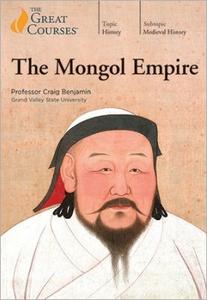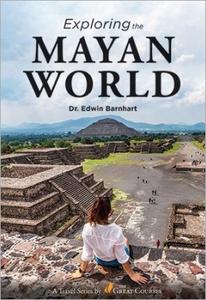TTC Video - The Mongol Empire
"softddl.org"
21-07-2020, 17:01
-
Share on social networks:
-
Download for free: TTC Video -
-

TTC Video - The Mongol Empire
Course No. 3158 | .MP4, AVC, 1900 kbps, 1280x720 | English, AAC, 96 kbps, 2 Ch | 24x28 mins | 9.73 GB
Lecturer: Craig G. Benjamin, Ph.D.

TTC Video - The Mongol Empire
Course No. 3158 | .MP4, AVC, 1900 kbps, 1280x720 | English, AAC, 96 kbps, 2 Ch | 24x28 mins | 9.73 GB
Lecturer: Craig G. Benjamin, Ph.D.
Picture these two scenes: In the first, you look over the wall of your city during the Middle Ages only to see the surrounding countryside choked with armed and mounted warriors, who have seemingly come from nowhere to ravage your ill-fated community. In the second, you have traveled for thousands of miles overland in relative safety, from Europe to an East Asian court that is civilized beyond compare, with foods, fabrics, technologies, and customs that will scarce be believed when you get back home.
These are two sides of the Mongol Empire, the largest, most brutal, and yet one of the most enlightened realms the world has ever known. Award-winning teacher and historian Professor Craig Benjamin brings both sides of this remarkable civilization to life in The Mongol Empire with 24 lectures that recount the storied conquests and achievements of the steppe nomads of Central Asia, who flourished from the 1100s to 1500s.
Even today, the Mongol conquerors are almost as shrouded in mystery as they were for the victims of their sudden raids so many centuries ago. Yet their empire was crucial to the fate of the religions of Islam and Orthodox Christianity and to the civilization of China. Plus, the long period of stability they brought to Central Asia opened the door to dependable commercial and cultural ties between Europe and East Asia. Indeed, many historians believe that the Mongol conquests, as violent as they were, helped usher in the modern world.
A Horde of Great Leaders
In The Mongol Empire, you learn that the internal politics between Mongol tribes could be intricate and bloody, with different relatives and factions fighting for control. However, among all the contenders for power, three great Mongol rulers stand out:
Chinggis Khan: Also spelled more familiarly as Genghis Khan, this military genius was almost solely responsible for creating the Mongol Empire in the early 1200s. He claimed a mandate from heaven to rule the world and came closer than anyone in history, ultimately controlling some nine million square miles-four times the size of the Roman Empire at its height.
Qubilai Khan: This fabled monarch in Samuel Taylor Coleridge's visionary poem, Kubla Khan, was a real Mongol emperor of China. A grandson of Chinggis Khan, Qubilai spent decades vanquishing China's Song dynasty and then presiding over a magnificent court, where he hosted the Italian traveler Marco Polo in the 1270s.
Timur: Also called Tamerlane due to his lameness, this ferocious warrior was responsible for millions of deaths in his conquests from Anatolia to India in the late 1300s and early 1400s. Timur left a bloodcurdling impression on the Western imagination, memorably in Christopher Marlowe's 16th-century play, Tamburlaine the Great.
You will also meet an army of lesser known but equally mighty khans, queens, and princes. Among them were Chinggis's son and immediate heir, Ogedai, who expanded his father's empire and kept it together thanks to his gift for administration; Toregene, who exercised complete power after the death of her husband, Ogedai; Batu, one of Chinggis's grandsons, who founded the Golden Horde division of the empire, which extended into Hungary and threatened the heart of Europe; Hulagu, another grandson, who invaded Persia and sacked Baghdad, ending the golden age of Islam; and Babur, related to Chinggis on his mother's side and Timur on his father's side, who established the Mughal dynasty in India, which dominated the subcontinent until the British arrived in the 18th century.
The Secret of Mongol Military Success
What made the Mongols so successful against first-class fighters like the Turks, Chinese, Persians, and the armored knights of Europe? Professor Benjamin analyzes the qualities that gave Mongol mounted archers a decisive edge, including:
Horsemanship: As pastoral nomads, the Mongols were superb horsemen, whose herding abilities were easily adapted to military-style raids. Moreover, their custom of large-scale hunts during winter lasting many weeks gave them experience in complex operations requiring discipline, coordination, and endurance.
Composite Bow: Arrows shot in rapid succession from composite bows were the Mongols' secret weapon. The bow was a laminate constructed from different types of wood, animal horn, and sinew. It allowed a short bow to store as much energy as a traditional long bow, which was too unwieldy for use while riding.
Siegecraft: Unique among nomads such as the Mongols, they acquired the skills of siegecraft so well they were rarely thwarted in their attempts to conquer cities. Their good treatment of captured artisans and craftsmen gave the Mongols access to the expertise needed to build catapults, scaling towers, and other siege engines.
Furthermore, the nature of the Eurasian steppe itself-a nearly unbroken grassland extending for 5,000 miles-gave the Mongols a sparsely populated homeland with ready access to rich civilizations on its periphery: China, India, Persia, Anatolia, and Europe. Few other groups knew how to survive on the arid steppe, whereas, the Mongols could easily disappear at the close of their campaigns only to reemerge months or years later, thousands of miles away, to menace a new target.
Epic Drama and Diverse Cultures
A pioneer in the discipline of "big history," Professor Benjamin is uniquely qualified to tell the complex story of the Mongol Empire. Big history uses a multidisciplinary approach, and Dr. Benjamin notes that the Mongols can only be truly understood when viewed in their environmental, geopolitical, and cultural contexts. In a wide-ranging exploration of these contexts, he makes a host of observations on topics such as:
Pastoralism: A hybrid of foraging and farming, pastoralism permitted humans to colonize the Eurasian steppe, especially after the domestication of the horse about 6,000 years ago. But pastoralism requires a nomadic way of life, constantly driving herds to fresh grasslands. It was this enforced mobility that molded the Mongol identity.
The Great Wall: The Chinese had suffered from nomad raids for centuries and had built fortifications to stop them. But the trauma inflicted by the Yuan dynasty, founded by Qubilai Khan, motivated the Chinese to construct "The Great Wall" after China regained power. Extending for thousands of miles, the wall successfully forestalled another Mongol invasion.
Religious Tolerance: Devoted to their sky god, Tengri, who had given them permission to conquer the whole world, the Mongols nonetheless tolerated other religions. Some khans even converted to Buddhism, Christianity, or Islam. Given the steady expansion of Islam into Central Asia, the Mongol khanates over time became predominately Muslim.
Professor Benjamin has journeyed extensively throughout the lands covered in this course. He reports on the unique beauty of the Eurasian steppe; the magnificence of the Mongols' sacred mountains; and the splendor of some of the chief cities in their empire, which still retain relics of Mongol rule. He even offers travel tips to destinations that are well worth an ambitious expedition off the beaten path.
But the most exciting expedition of all is this course: The Mongol Empire offers you incredible drama in diverse cultures, in a remote period, and across fully one-fourth of the Earth's circumference. As you will see, the epic of the Mongols is one of the most extraordinary stories in the long annals of world history.
Buy Premium From My Links To Get Resumable Support,Max Speed & Support Me

https://uploadgig.com/file/download/8F95e022162db25c/t43ka.TTC.Video..The.Mongol.Empire.part1.rar
https://uploadgig.com/file/download/4f82a0f1f8b9160e/t43ka.TTC.Video..The.Mongol.Empire.part2.rar
https://uploadgig.com/file/download/2f998A7974501849/t43ka.TTC.Video..The.Mongol.Empire.part3.rar

https://rapidgator.net/file/267e86adfd623d3eea53083a34a16b4b/t43ka.TTC.Video..The.Mongol.Empire.part1.rar
https://rapidgator.net/file/076fe0bc734f9b46eb371090e77863c8/t43ka.TTC.Video..The.Mongol.Empire.part2.rar
https://rapidgator.net/file/76f510191cf7bd36cf218873d8bda24b/t43ka.TTC.Video..The.Mongol.Empire.part3.rar

http://nitroflare.com/view/FE04B6D66E76F3A/t43ka.TTC.Video..The.Mongol.Empire.part1.rar
http://nitroflare.com/view/221E269B86A3000/t43ka.TTC.Video..The.Mongol.Empire.part2.rar
http://nitroflare.com/view/92EBE36FEA7C856/t43ka.TTC.Video..The.Mongol.Empire.part3.rar
The minimum comment length is 50 characters. comments are moderated

![TTC Video - The Big History of Civilizations [720p]](https://i112.fastpic.ru/big/2020/0721/a6/2805da15abcade96b2c9f732499b2ea6.jpeg)


